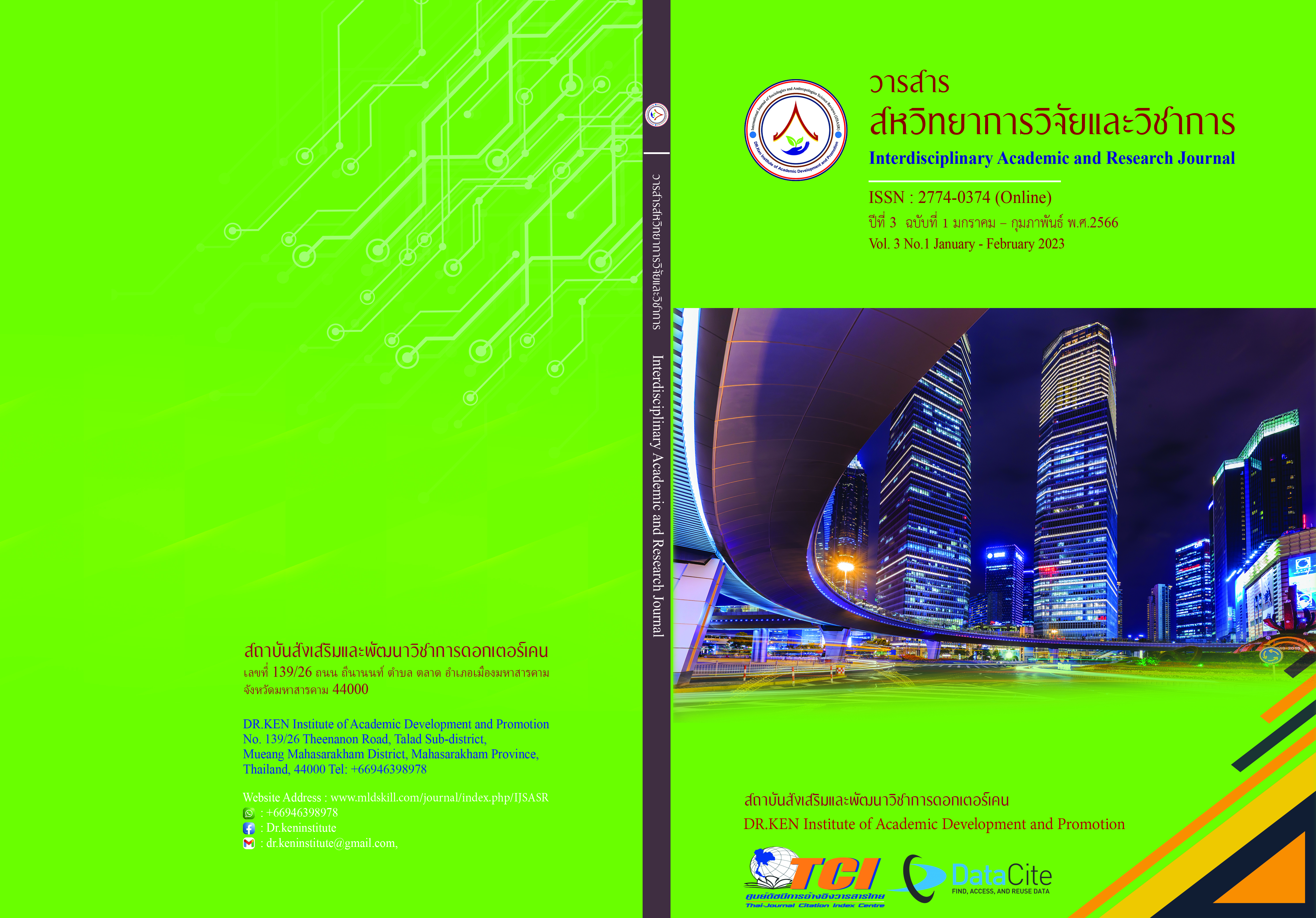Construction of a Diagnostic Test for Mathematical Problem-Solving of Prathomsuksa 3 Students in Schools under Taling Chan District Office, Bangkok
DOI:
https://doi.org/10.14456/iarj.2023.21Keywords:
Diagnostic Test; , Mathematics Problem-solving; , Language Comprehension in Problem-solving of Prathomsuksa 3 StudentsAbstract
Solving math problems is one of the learning processes that students should practice and develop themselves to develop this skill. This is to create a new body of knowledge to know how to apply and modify methods to solve problems as appropriate, and to know how to investigate and reflect on the problem-solving process. However, in the construction of mathematical problem-solving diagnostic tests, the importance of problem-solving steps was emphasized. Thus, the objectives of this research were (1) to construct a diagnostic test for mathematical problem-solving and (2) to analyze the shortcomings in solving mathematical problems that were found after using the test. Samples were 296 Prathomsuksa 3 students in the schools under Taling Chan District Office, Bangkok using a multi-stage random sampling technique. Data were collected by using the diagnostic test for mathematical problem-solving. The test is divided into 2 parts; the language comprehension test, and the mathematical problem-solving test. And the test examined content validity, reliability, item difficulty, and item discrimination to show test quality. Data were analyzed with descriptive statistics. The research results found that (1) The content validity of all items in the language comprehension test showed the IOC index equal to 1.00 and also showed the same index in the mathematical problem-solving test. (2) The reliability of the language comprehension test was .97 and the mathematical problem-solving test was .98. (3) The language comprehension test had an item difficulty index between 0.51 to 0.62 and an item discrimination index between 0.62 to 0.90. The mathematical problem-solving test had an item difficulty index between 0.11 to 0.66 and an item discrimination index between 0.21 to 0.90. (4) The most shortcomings were found in students who got grade scores of 2 and 2.5. In the language comprehension test. It showed that 4 over 5 kinds of calculation methods and all steps of mathematical problem solving were wrong.
References
กระทรวงศึกษาธิการ. (2560). ตัวชี้วัดและสาระการเรียนรู้แกนกลาง กลุ่มสาระการเรียนรู้คณิตศาสตร์ (ฉบับปรับปรุง พ.ศ. 2560) ตามหลักสูตรแกนกลางการศึกษาขั้นพื้นฐาน พุทธศักราช 2551. กรุงเทพฯ : โรงพิมพ์ชุมนุมสหกรณ์การเกษตรแห่งประเทศไทย จำกัด.
ธวชินี มาหล้า. (2561). การพัฒนาแบบทดสอบวินิจฉัยทักษะการคิดคำนวณและการให้เหตุผลกลุ่มสาระการเรียนรู้คณิตศาสตร์ สำหรับนักเรียนชั้นประถมศึกษาปีที่ 3 ในเขตพื้นที่การศึกษาประถมศึกษาลำปางเขต 2. วิทยานิพนธ์ศึกษาศาสตรมหาบัณฑิต มหาวิทยาลัยสุโขทัยธรรมาธิราช, นนทบุรี.
ปนัสยา เบื้องบน. (2564). การสร้างแบบทดสอบวินิจฉัยจุดบกพร่องในการเรียนวิชาคณิตศาสตร์ เรื่อง การแก้โจทย์ปัญหาเศษส่วนและจำนวนคละ สำหรับนักเรียนชั้นประถมศึกษาปีที่ 6 โรงเรียนอนุบาลประโคนชัย (อำนวยกิจราษฎร์วิทยาคาร). การประชุมวิชาการระดับชาติและนานาชาติ ครั้งที่ 4 (น169 – 181). มหาวิทยาลัยราชภัฎบุรีรัมย์.
พรเพชร พิศคำ (2561). การสร้างแบบทดสอบวินิจฉัยและแนวทางการแก้ไขข้อบกพร่องในการเรียนคณิตศาสตร์ เรื่องเมทริกซ์ สำหรับนักเรียนชั้นมัธยมศึกษาปีที่ 4. วารสารการวัดผลการศึกษา มหาวิทยาลัยมหาสารคาม. 24(2), 153-165.
พิชชานันท์ แมคคอร์มิค (2562). การสร้างแบบทดสอบวินิจฉัยทางการเรียน เรื่อง จำนวนและการดำเนินการ กลุ่มสาระ การเรียนรู้คณิตศาสตร์ชั้นประถมศึกษาปีที่ 6 สังกัดสำนักงานเขตพื้นที่การศึกษา ประถมศึกษาหนองบัวลำภู เขต 1. วารสารสถาบันวิจัยและพัฒนา มหาวิทยาลัยราชภัฏมหาสารคาม, 6(2), 163-176.
ล้วน สายยศ และอังคณา สายยศ. (2543). เทคนิคการวิจัยทางการศึกษา. พิมพ์ครั้งที่ 3. กรุงเทพฯ: สุวีริยาสาส์น.
ศิริชัย กาญจนวาสี. (2556). ทฤษฎีการทดสอบแบบดั้งเดิม. พิมพ์ครั้งที่ 7. กรุงเทพฯ : โรงพิมพ์แห่งจุฬาลงกรณ์มหาวิทยาลัย.
สถาบันทดสอบทางการศึกษาแห่งชาติ. (2563). สรุปผลการทดสอบทางการศึกษาระดับชาติขั้นพื้นฐาน (O-NET). Retrieved on April 10, 2020, from: https://www.niets.or.th/th.
สถาบันส่งเสริมการสอนวิทยาศาสตร์และเทคโนโลยี. (2560). ทักษะและกระบวนการทางคณิตศาสตร์. กรุงเทพฯ: ซีเอ็ดยูเคชั่น.
สำนักงานเขตตลิ่งชัน กรุงเทพมหานคร. (2563). ข้อมูลนักเรียนและสถานศึกษาในเขตพื้นที่บริการ. Retrieved on 27 September 2020 from: http://school.bangkok.go.th
สุวิมล ติรกานันท์. (2557). ระเบียบวิธีการวิจัยทางสังคมศาสตร์: แนวทางสู่การปฏิบัติ. พิมพ์ครั้งที่ 12. กรุงเทพฯ: โรงพิมพ์แห่งจุฬาลงกรณ์มหาวิทยาลัย.
อัสมาอ์ หะยีตาเฮร์. (2560). ผลการสอนโดยใช้วิธีการแบบแดที่มีต่อความสามารถในการแก้โจทย์ปัญหาคณิตศาสตร์นักเรียนชั้นมัธยมศึกษาปีที่ 2. วารสารศึกษาศาสตร์มหาวิทยาลัยสงขลานครินทร์ วิทยาเขตปัตตานี, 29(1), 182-193.
Carla, L. (2020). Culturally appropriate math problem-solving instruction with English language learners. School Psychology Review, 49(2), 144-160.
Ethan, V. (2019). Cognitive ability and math computation developmental relations with math problem solving an integrated, multigroup approach. School Psychology Review, 34(1), 96-108.
Fengfeng, K. (2020). Game-based multimodal representations and mathematical problem solving. International Journal of Science and Mathematics Education, 18(1), 103-122.
Frankel, J. R. & Wallen, N. E. (1999). How to design and evaluate research in education. (4th .Ed). Boston, MA: McGraw Hill.
Jacobs, L. C. (1991). Test reliability. IU Bloomington Evaluation Services and Testing (BEST), Indiana University Bloomington. Last updated: Tuesday, 14-Dec-2004 11:21:32 Est
Krejcie, R. V. & Morgan, D. W. (1970). Determining Sample Size for Research Activities. Educational and Psychological Measurement, 30(3), 607-610.
Michael, W. (2021). Improvements in motor competence skills are associated with improvements in executive function and math problem-solving skills in early childhood. Developmental Psychology, 57(9), 1463-1470.
Ozkubat, U. (2021). Investigation of effects of cognitive strategies and metacognitive functions on mathematical problem-solving performance of students with or without learning disabilities. International Electronic Journal of Elementary Education, 13(4), 443-456.
Rahayuningsih, S. (2021). Cognitive flexibility: exploring students’ problem-solving in elementary school mathematics learning. Journal of Research and Advances in Mathematics Education, 6(1), 59-70.
Tambychik, T. & Meerah, S. (2010). Students’ Difficulties in Mathematics Problem-Solving: What do they Say? International Conference on Mathematics Education Research, 8, 142-151.
Vyacheslav, V. U. (2020). Solving math problems through the principles of scientific creativity. EURASIA Journal of Mathematics, Science and Technology Education, 16(10), 1-9.
Downloads
Published
How to Cite
Issue
Section
License
Copyright (c) 2023 ณัฐกาณญ์ สนธิกัน, สุวิมล ติรกานันท์, กมลทิพย์ ศรีหาเศษ

This work is licensed under a Creative Commons Attribution-NonCommercial-NoDerivatives 4.0 International License.
Copyright on any article in the Interdisciplinary Academic and Research Journal is retained by the author(s) under the under the Creative Commons Attribution-NonCommercial-NoDerivatives 4.0 International License. Permission to use text, content, images, etc. of publication. Any user to read, download, copy, distribute, print, search, or link to the full texts of articles, crawl them for indexing, pass them as data to software, or use them for any other lawful purpose. But do not use it for commercial use or with the intent to benefit any business.
















.png)


